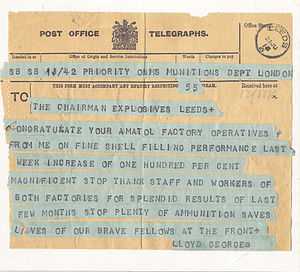Telegram style

Telegram style, telegraph style, telegraphic style or telegraphese[1] describes a clipped way of writing that attempts to abbreviate words and pack as much information into the smallest possible number of words and/or characters.
It originated in the telegraph age when telecommunication consisted only of short messages transmitted by hand over the telegraph wire. The telegraph companies charged for their service by the number of words in a message, with a maximum of 15 characters per word for a plain-language telegram, and 10 per word for one written in code. The style developed to minimize costs but still convey the message clearly and unambiguously.
Related but distinct, is the historical practice of using abbreviations and code words to compress the meaning of phrases into a small set of characters for ease of transmission over a telegraph, a device for transmitting electrical impulses used for communications, introduced from 1839 onwards. The related term cablese describes the style of press messages sent uncoded, but in a highly condensed, Hemingwayesque style, over submarine communications cables. In the U.S. Foreign Service, before the advent of broadband telecommunications, cablese referred to condensed telegraphic messaging that made heavy use of abbreviations and avoided use of definite or indefinite articles, punctuation, and other words unnecessary for comprehension of the message.
A characteristic is the use of the word STOP for a full stop character:
eg t-gram style stop
Example
Orville Wright's telegram of December 17, 1903 about the first powered flight.
Success four flights thursday morning all against twenty one mile wind started from Level with engine power alone average speed through air thirty one miles longest 57 seconds inform Press home Christmas . Orevelle Wright
Antecedents
Before the telegraph age military dispatches from overseas were made by letters transported by rapid sailing ships. Clarity and concision were often considered important in such correspondence.
An apocryphal story about the briefest correspondence in history has a writer (variously identified as Victor Hugo or Oscar Wilde) inquiring about the sales of his new book by sending the message "?" to his publisher, only to receive "!" in reply.[2]
Telegraphic coded expressions
Through the history of telegraphy, very many dictionaries of telegraphese, codes or ciphers were developed, each serving to minimise the number of characters or words which needed to be transmitted in order to impart a message; the drivers for this economy were, for telegraph operators, the resource cost and limited bandwidth of the system; and for the consumer, the cost of sending messages.
Examples of telegraphic coded expressions, taken from The Adams Cable Codex, Tenth Edition, 1896 are:
- Emolument — Think you had better not wait
- Emotion — Think you had better wait until -
- Emotional — Think you had better wait and sail -
- Empaled — Think well of party mentioned
- Empanel — This is a matter of great importance.
and from The A.B.C. Universal Commercial Electric Telegraphic Code
- Nalezing — Do only what is absolutely necessary
- Nalime — Will only do what is absolutely necessary
- Nallary — It is not absolutely necessary, but it would be an advantage
- Naloopen — It is not absolutely necessary, but well worth the outlay
Other languages
In Japanese, telegrams are printed using the katakana script, one of the few instances in which this script is used for entire sentences.
In some ways, "telegram style" was the precursor to the modern language abbreviations employed in "texting" or the use of short message standard (SMS) services such as Twitter. On telegrams, space was at a premium—economically speaking—and abbreviations were used as a matter of necessity.
See also
References
- ↑ Alred, Brusaw, and Oliu. Handbook of Technical Writing, Seventh Edition. New York, New York: St. Martins Press, 2003., p.522
- ↑ O’Toole, Garson (2014-06-14). "Briefest Correspondence: Question Mark? Exclamation Mark!". Quote Investigator. Retrieved 2014-06-15.
- "HOW TO WRITE TELEGRAMS PROPERLY" A Small Booklet by Nelson E. Ross, 1928
- Notes on Writing Richard N. Langlois, February 1997. University of Connecticut. Accessed February 2008
- Standage, Tom. The Victorian Internet. ISBN 0-8027-1342-4 for hardback, ISBN 0-425-17169-8 for paperback.
- Telegraphic codes and message practice, 1870-1945
Photo gallery
-

President Ho Chi Minh to President Truman 1946
-

Telegram of 21 June 1916 from David Lloyd George, Minister of Munitions, to Joseph Watson, Chairman of Barnbow Amatol shell-filling factory.